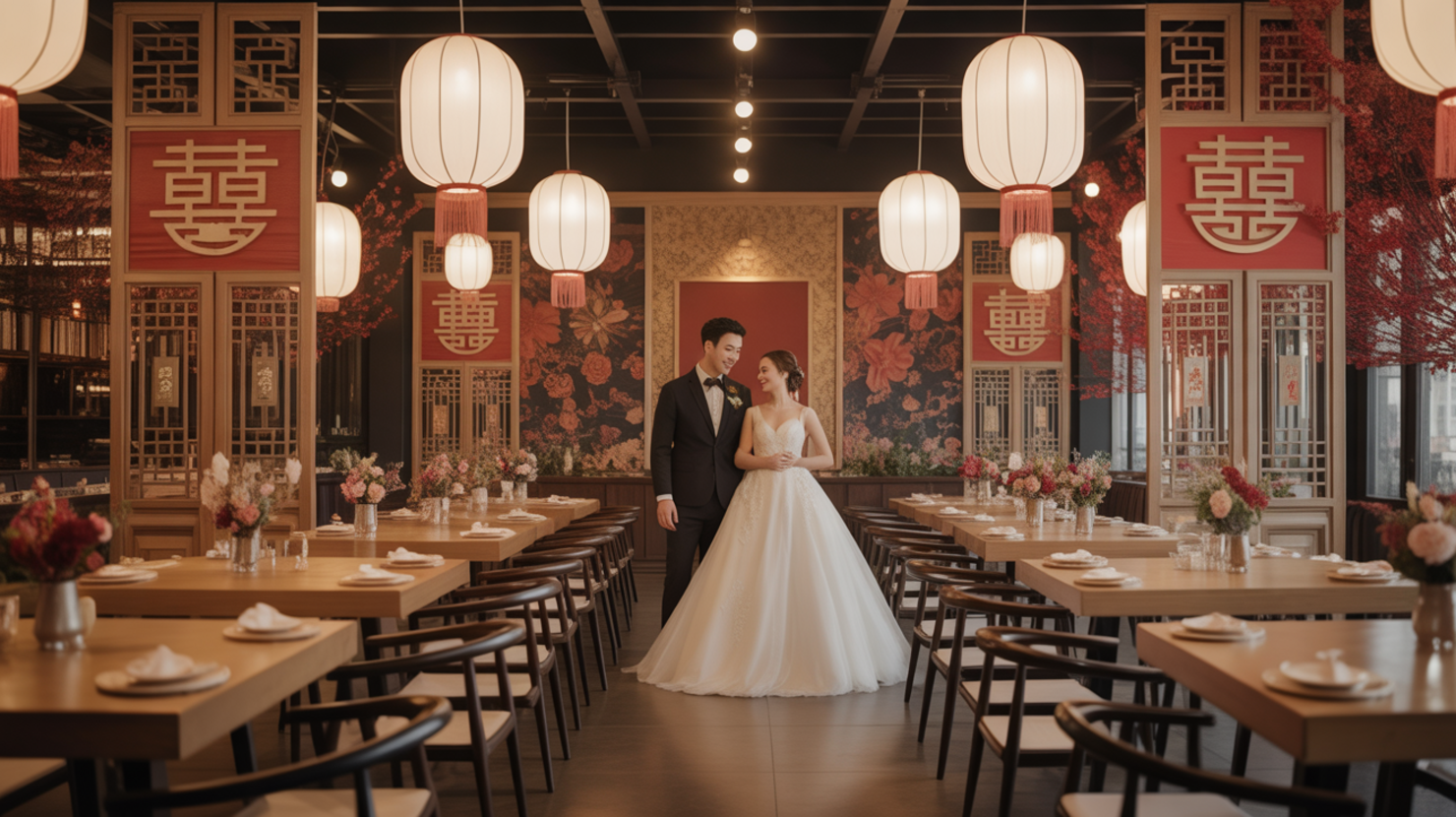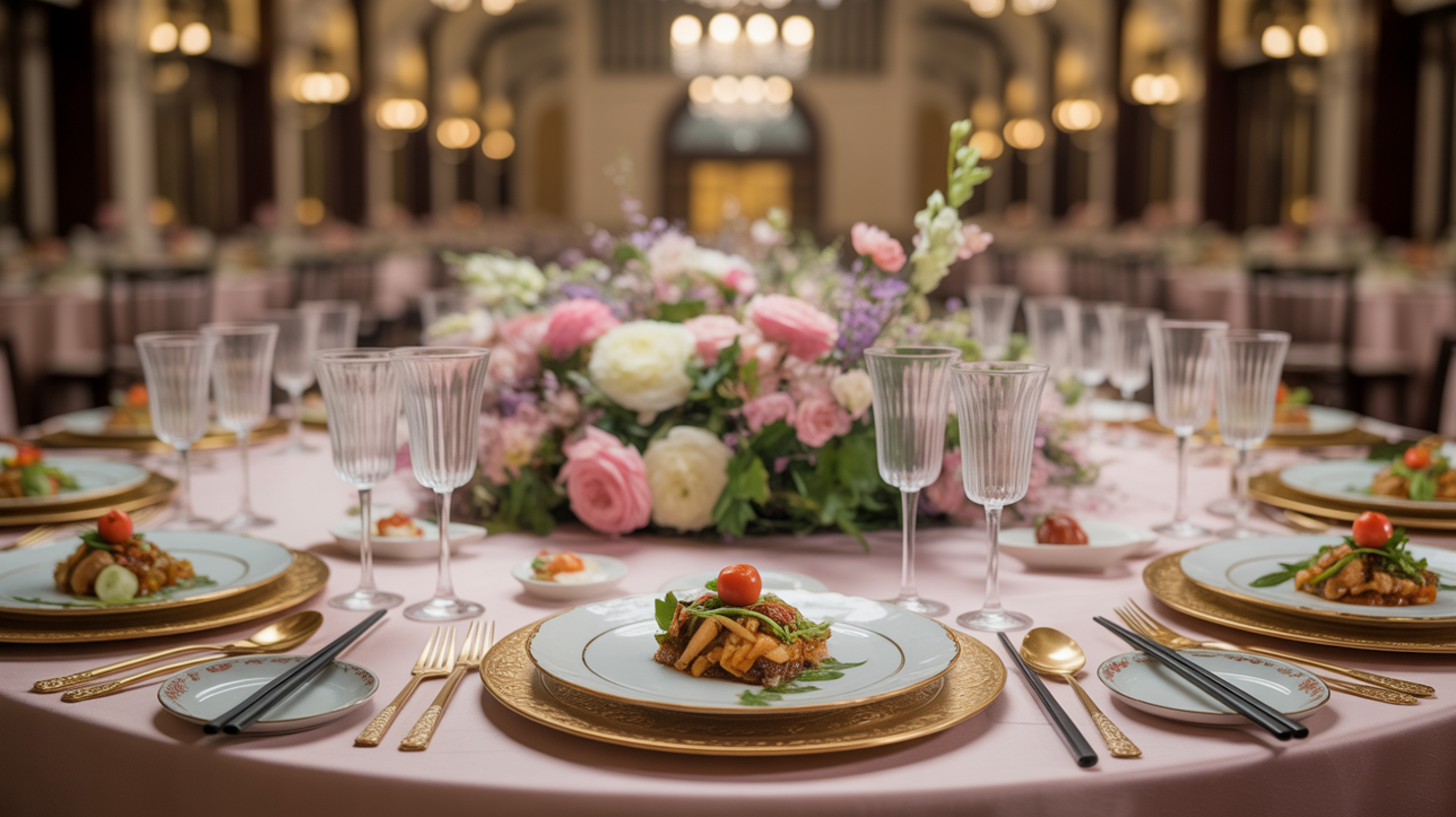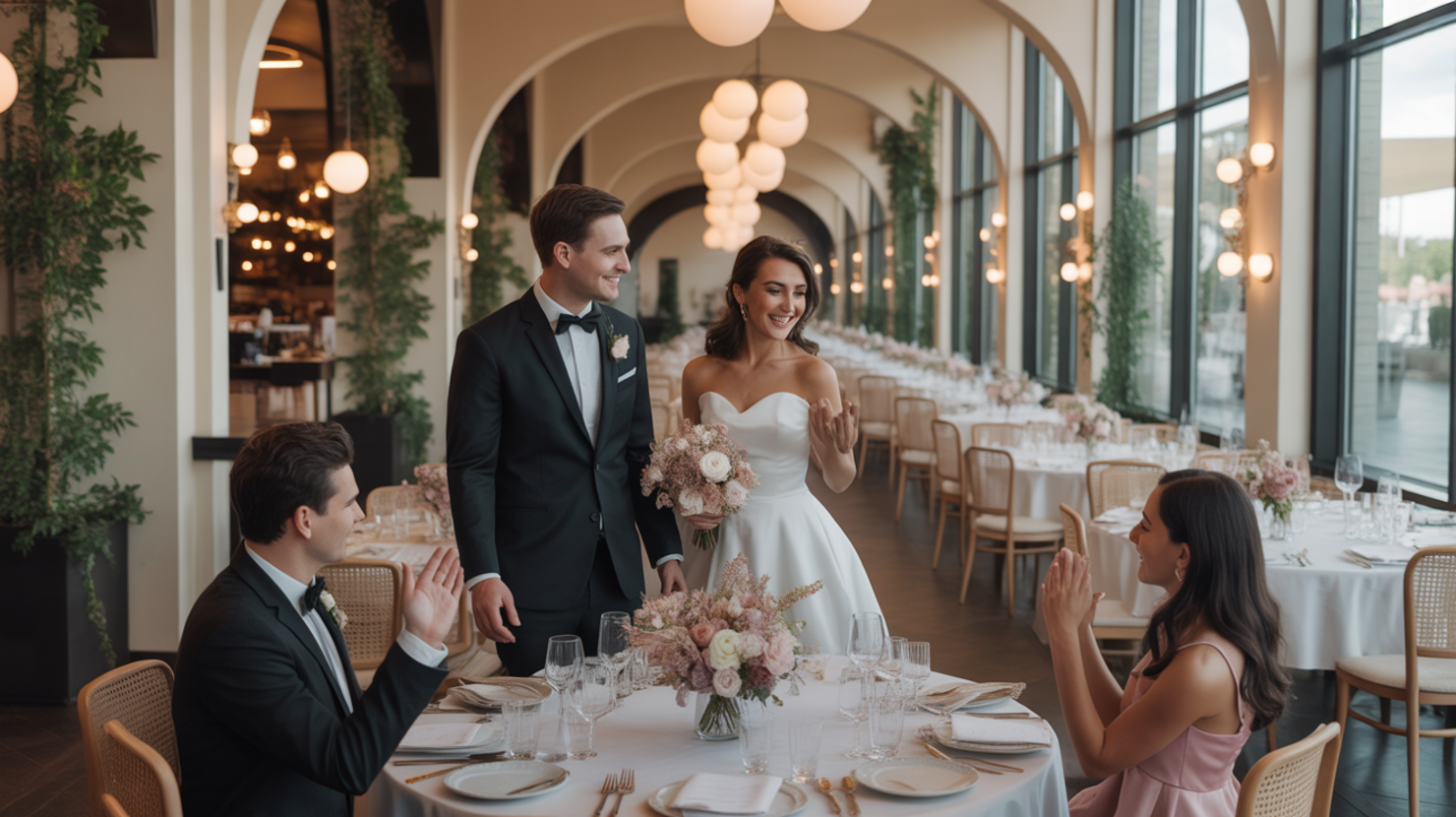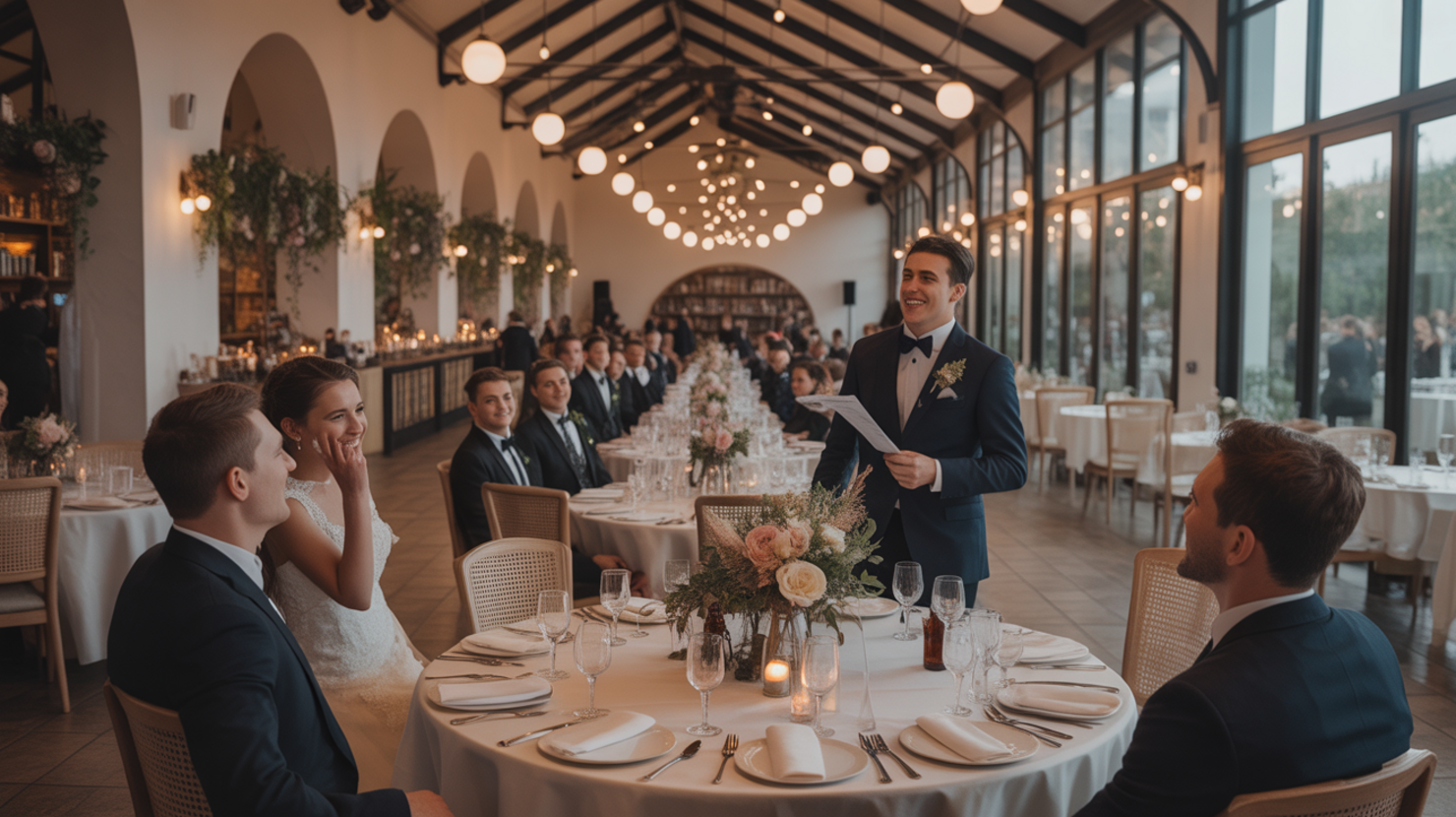Selecting a Venue With Balanced Architectural Features ✨
Choosing the right setting is the crucial first step in successfully blending modern décor with traditional Chinese elements for your restaurant wedding. The venue itself acts as the foundation, and opting for one with a balanced architectural style can significantly simplify your design process. Look for spaces that feature clean lines and open layouts. Modern architecture often provides this kind of minimalist backdrop, which serves as a versatile canvas. An open floor plan allows for flexibility in arranging seating and décor, making it easier to incorporate diverse elements without feeling cluttered.
Equally important is seeking venues that might already possess existing symbolic or traditional features. Think about locations that subtly incorporate elements like intricate latticework, decorative panels, or even materials commonly used in traditional Chinese design, such as dark woods or natural stone. Finding a venue that already has these touches integrated into its architecture provides a head start, offering authentic traditional anchors around which you can layer contemporary design choices. This inherent character can add depth and meaning without requiring extensive temporary installations. Exploring potential venues and their existing features is key; resources like wedding venue directories can be a great place to start your search for spaces that offer this kind of balance. (For example, check out resources on sites like The Knot for local options).
Furthermore, prioritize venues with flexible dining areas. Weddings often involve specific seating arrangements, whether adhering to traditional round tables for family gatherings or opting for more modern, long banquet-style setups. A flexible space allows you to experiment with different configurations, seamlessly integrating seating plans that reflect both aesthetics. This adaptability is vital for pulling off a blended style, ensuring that the flow of the event feels natural and accommodates both modern design principles and traditional ceremonial aspects. Having freedom in layout also gives you more room for placing key decorative pieces, from sleek floral arrangements to traditional ceremonial backdrops, creating a cohesive yet dynamic visual experience. Focusing on these architectural aspects early ensures your design plan has a solid and harmonious base.
Modern Color Palettes Meet Traditional Symbolism 🎨
Color plays a pivotal role in setting the mood and conveying meaning in any design, and in a restaurant wedding blending modern and traditional Chinese elements, it’s where this fusion truly shines. By carefully selecting and combining hues, you can create an atmosphere that feels both contemporary and deeply rooted in cultural heritage. It’s about finding harmony between bold, symbolic shades and sophisticated, modern tones.
One effective strategy is to pair muted neutrals with bold red and gold accents. Think soft grays, creams, or blush pinks as your base. These provide a clean, modern backdrop that allows traditional colors to make a powerful statement without overwhelming the space. Red is paramount in Chinese culture, symbolizing joy, luck, and happiness – essential for a wedding celebration. Gold signifies prosperity and wealth. Using these vibrant colors in carefully chosen accents, such as linens, floral arrangements, or decorative details, instantly infuses the space with traditional auspiciousness against a chic, minimalist canvas. For more on the significance of these colors, you can read about Chinese wedding traditions on resources like The Knot.
Bringing modern touches to classic items adds another layer of depth. Consider using contemporary metallic finishes on classic ceramicware. Instead of traditional matte finishes, opt for plates, vases, or decorative bowls with subtle metallic glazes – perhaps a rose gold rim or a platinum accent. This small detail elevates the timeless beauty of Chinese ceramics with a modern, luxurious feel, creating a sophisticated blend of old and new on your tablescapes and display areas.
Visual contrast is key to a dynamic design. Incorporating dual-tone drapery can provide this beautifully. Imagine rich red curtains layered with sheer, modern white or gray panels, or gold fabric combined with a sophisticated neutral. This layering technique adds texture, visual interest, and a sense of depth to the space. It allows you to play with light and shadow while subtly integrating the symbolic colors in a contemporary way, creating a backdrop that feels both elegant and culturally resonant. By thoughtfully combining these color strategies, you can craft a wedding aesthetic that honors tradition while embracing modern style, creating a truly memorable celebration.
Furniture Fusion: Sleek Lines & Heritage Pieces 🛋️
Achieving a harmonious blend of modern and traditional Chinese aesthetics in your restaurant wedding décor often culminates in the thoughtful selection and arrangement of furniture. This isn’t about choosing one style over the other, but rather finding the perfect synergy between sleek, minimalist modern design and ornate, symbolic heritage pieces. The contrast creates visual interest and tells a rich story.
Consider the seating arrangements. While contemporary banquet seating offers clean lines and comfort, it can be elevated by layering it with beautiful silk cushions adorned with traditional patterns or auspicious symbols. For accent seating or specific lounge areas, imagine the striking effect of pairing ultra-modern, perhaps acrylic chairs, with the intricate craftsmanship of carved wooden screens. These screens don’t just divide space; they act as art installations rooted in tradition, providing a warm counterpoint to the modern seating.
Displaying cultural artifacts or family heirlooms adds a deeply personal touch. Rather than simply placing them on tables, present them intentionally. Ancestral tea sets, delicate ceramics, or other small decorative items can be showcased beautifully within glass display cases. This protects the precious items while allowing guests to appreciate their detail and history, contrasting the old-world charm within a contemporary, transparent structure.
This approach to furniture fusion allows you to curate spaces that feel both current and timeless. It respects the beauty and history of traditional Chinese furniture while embracing the functionality and aesthetic of modern design. The key is balance and thoughtful placement, ensuring each piece contributes to the overall narrative of unity and celebration.
Here are key furniture fusions to consider:
- Pairing modern seating (like acrylic chairs or minimalist benches) with carved wooden screens.
- Enhancing minimalist banquet seating with luxurious silk cushions.
- Showcasing traditional items like ancestral tea sets in contemporary glass display cases.
Lighting Strategies Bridging Eras 💡
Lighting plays a pivotal role in shaping the mood and highlighting key decorative elements in any space, and it’s particularly powerful when blending distinct styles. In your restaurant wedding, strategic lighting can beautifully bridge the gap between contemporary design sensibilities and rich traditional Chinese aesthetics, creating an ambiance that is both modern and deeply respectful of heritage. Here are key strategies to consider.
One effective approach is to reinterpret traditional forms using modern technology. Consider suspending LED-lit paper lanterns above dining tables or in gathering areas. Classic paper lanterns are quintessential symbols of Chinese celebration, but by using energy-efficient, bright LED lights, you give them a clean, modern illumination that feels fresh and contemporary while retaining their cultural significance. Varying sizes and heights can add visual dynamism to the ceiling space.
Modern directional lighting can also be used to draw attention to traditional art pieces. If you are incorporating elements like calligraphy scrolls, intricate paintings, or decorative screens, use focused directional spotlights to highlight them. This technique, often seen in galleries, elevates these cultural artifacts, presenting them as valuable art installations within the contemporary setting. It allows guests to appreciate the detail and beauty of traditional artwork, making it a focal point rather than just background décor.
Finally, leveraging modern dimmable lighting systems offers immense flexibility for mood transitions throughout the event. A bright, airy feel might be perfect for the arrival and dinner, but dimming the lights can create a more intimate, romantic, or energetic atmosphere for dancing or speeches. These systems allow you to seamlessly transition between different phases of the wedding celebration, ensuring the lighting always complements the current mood and activity, integrating modern technological control with the desired traditional or contemporary ambiance at different moments.
By thoughtfully implementing these lighting strategies, you ensure that the ambiance of your restaurant wedding reflects the beautiful fusion of modern style and timeless Chinese tradition, creating a visually stunning and memorable experience for everyone.
Contemporary Table Settings With Cultural Motifs 🍽️
The table setting is arguably the most intimate part of your wedding décor, where guests gather, share meals, and create memories. For a restaurant wedding blending modern and traditional Chinese elements, the table offers a perfect canvas. It’s about weaving contemporary aesthetics with meaningful cultural motifs to create a sophisticated, personal, and culturally resonant look.
Begin with thoughtful details like napkins. Consider folding elegant, modern fabric napkins – perhaps in muted tones or luxurious silks – into the shape of a lotus. The lotus flower is a powerful symbol in Chinese culture, representing purity, rebirth, and love. This simple act transforms a common item into a piece of décor rich with symbolism, beautifully merging modern materials with timeless cultural imagery.
The foundation involves the dinnerware. Pair modern, sleek cutlery – perhaps in gold or brushed silver – with classic porcelain charger plates. This juxtaposition of contemporary metallic finishes with the traditional elegance of porcelain creates visual interest and speaks to the blend you’re aiming for. Incorporate small, exquisite traditional elements like delicate Chinese teacups or stylish chopstick rests alongside modern cutlery, adding functional beauty.
Integrate cultural patterns subtly. The double-happiness symbol (囍) is central to Chinese weddings, signifying joy and bliss. Instead of overt displays, embed this pattern subtly in elements like placemats or table linens. Think a delicate blind emboss on sophisticated paper placemats, a watermark on menu cards, or the pattern woven subtly into fabric runners. This honors tradition in a refined, contemporary manner without overwhelming the modern aesthetic. You can learn more about this symbol on Wikipedia.
By focusing on these contemporary table settings with cultural motifs, you create a dining experience that is both visually stunning and deeply meaningful. Each element contributes to an atmosphere celebrating both your modern style and rich heritage, making your restaurant wedding truly unforgettable.
Floral Designs Merging East-West Aesthetics 🌸
Flowers play a central role in wedding celebrations, adding beauty, fragrance, and symbolic meaning. For a wedding blending modern sensibilities with traditional Chinese culture in a restaurant setting, your floral designs offer a stunning opportunity to bridge East-West aesthetics. This isn’t just about choosing specific blooms, but how they are arranged and presented, creating visual harmony that reflects the union itself.
Think beyond conventional bouquets and centerpieces. One innovative approach is to arrange traditional Chinese flowers, like the auspicious peony, within contemporary vessels such as geometric terrariums. This juxtaposition of soft, romantic blooms with sharp, modern shapes creates a striking visual impact, perfect for tabletop displays or entrance accents. It signifies honoring heritage while embracing a forward-looking design perspective. Learn more about the symbolism of flowers here.
Structural elements also offer intriguing possibilities. Bamboo stalks, revered in Chinese culture for their strength and resilience, can be artfully woven into cascading centerpieces. Instead of just using flowers, incorporate the elegant lines of bamboo to add height, texture, and a touch of natural architecture to your tablescapes. This creates a dynamic look that feels both grounded in tradition and refreshingly modern. The interplay between the organic form of bamboo and perhaps more structured floral arrangements can be truly captivating.
Furthermore, classic Chinese blooms like orchids can be integrated into contemporary floral styles. Consider adding exquisite orchid sprays to monochromatic modern bouquets or minimalist arrangements. The elegance of the orchid stands out beautifully against a backdrop of single-color blooms or simple greenery, adding a touch of sophistication and cultural depth without overwhelming the clean aesthetic. This approach ensures your floral design feels cohesive, intentional, and perfectly suited to your blended theme.
Cultural Entertainment Reimagined Digitally 📺
Blending the timeless elegance of traditional Chinese culture with the sleek efficiency of modern design extends beautifully to your wedding entertainment. Instead of being limited by venue constraints or logistical challenges, technology offers innovative ways to incorporate vibrant cultural elements, making your celebration both deeply meaningful and cutting-edge.
One captivating way to achieve this is through digital visual art. During moments like dinner service or heartfelt speeches, imagine the backdrop transforming into a living canvas. Projecting animated ink paintings, inspired by classical Chinese art, can create a serene and sophisticated atmosphere. These dynamic visuals add a layer of cultural depth without cluttering the physical space, providing a stunning conversation piece that respects traditional aesthetics through a modern medium.
Traditional live performances, such as the energetic lion dance, are cornerstones of many Chinese celebrations. However, venue size, flooring, or permit requirements might make a full live performance challenging indoors. This is where streaming technology shines. You can arrange for a performance in a suitable outdoor area or even a dedicated space, capturing it professionally and streaming the lion dance live to strategically placed screens throughout the venue. This ensures all your guests, regardless of their location, can witness the spectacle, bringing the powerful symbolism and excitement directly to them in real-time.
Finally, let’s look at the cherished tradition of giving red envelopes (hóngbāo). While the physical act remains popular, digitizing aspects can streamline the process for modern guests and provide innovative alternatives. Consider setting up a digital red envelope gift station. This could involve QR codes linked to secure digital payment platforms, allowing guests to contribute electronically while still conveying their blessings. You could even integrate this with a digital guestbook or photo booth, allowing guests to record a video message along with their digital gift, modernizing the tradition while preserving its spirit of generosity and good fortune. For ideas on integrating technology smoothly, resources like wedding technology blogs offer great insights.
By embracing these digital innovations, you can ensure that the rich cultural entertainment and traditions are not just present but are seamlessly integrated into your modern wedding design, creating a truly unique and unforgettable experience for everyone.
Future-Proofing Traditions Through Tech Integration 📱
Blending modern and traditional elements in a restaurant wedding is about more than just aesthetics; it’s also about preserving and sharing the rich cultural heritage in innovative ways. Technology offers exciting avenues to engage guests and provide deeper context to traditional symbols and practices, ensuring these meaningful details aren’t lost on a modern audience. Integrating tech thoughtfully can create memorable, interactive experiences that honor the past while embracing the future.
One fascinating application is using Augmented Reality (AR). Imagine guests pointing their smartphones at a traditional decoration, a specific dish, or a piece of art, and seeing a digital overlay that explains its historical significance or symbolic meaning. This transforms static elements into dynamic learning opportunities, allowing guests to easily discover the stories behind the traditions, making the cultural aspects feel more accessible and engaging. Learn more about AR technology.
Similarly, QR codes can be strategically placed throughout the venue. These simple codes, scannable with any smartphone, can link to digital content such as short videos explaining wedding customs, the history of specific symbols (like the double happiness character), family stories, or even digital photo albums showcasing traditions from past generations. Embedding QR codes in table centerpieces, menus, or guest favors provides a subtle yet powerful way to share cultural narratives and deepen guest appreciation. Understand how QR codes work.
Smart lighting systems offer another powerful tool for enhancing the wedding experience while subtly referencing tradition. These systems can be pre-programmed to change lighting schemes throughout the event, shifting moods seamlessly from a warm, intimate glow for the ceremony to vibrant, celebratory colors for the reception. Lighting can even incorporate traditional color symbolism, like red for luck and happiness, creating a dynamic visual narrative that complements the flow of the event and enhances the overall atmosphere.
Here are key ways technology can future-proof traditions:
- Developing AR experiences to explain symbolic elements interactively.
- Embedding QR codes in décor for accessible cultural storytelling.
- Using smart lighting to shift between ceremony phases and moods.
By thoughtfully weaving these technological tools into your wedding design, you can create an event that is not only visually stunning and harmoniously blended but also provides a rich, engaging, and educational experience, ensuring the beauty and meaning of cultural traditions resonate with every guest.



